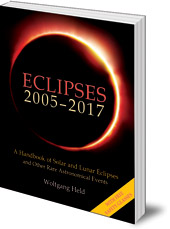Quick Look
Provides detailed information on where to see the best solar and lunar eclipses for the next few years, maps to guide you to the best spot and tips for making the most of an eclipse. Includes free safety glasses for viewing the sun.
Description
-- Maps to guide you to exactly the best viewing spot
-- Tips for making the most of an eclipse
-- Includes free safety glasses for viewing the sun
A solar eclipse is an awe-inspiring spectacle if you are in the path of totality. Getting to the right spot at exactly the right time, and knowing how best to view the eclipse, though, can be difficult.
This is the handbook that serious and amateur eclipse viewers alike have been waiting for. It provides, in intricate detail, information on where best to see the solar and lunar eclipses that are visible from the earth, for the next few years. Easy to follow, high-quality maps are included, especially useful if the best viewing point is quite remote. The author provides comprehensive background information on each eclipse, and hundreds of useful tips for how to make the most of the few minutes of this awe-inspiring phenomena.
The book comes bundled with free safety glasses for viewing the sun.
Table of Contents
The awe-inspiring spectacle of a solar eclipse
Observing eclipses
-- Finding a good place
-- A peaceful place
-- The drama of the events
-- Protecting your eyes
How does an eclipse happen
-- The path of the moon around the earth
-- A solar eclipse
-- The inclination of the moon's path
-- The movement of the nodes
-- Saros periods: the 42 eclipse families
-- Eclipses and their effect in nature
Total and annular eclipses 2005-2017
The character of a lunar eclipse
Lunar eclipses 2005-2017
The character of sun and moon and their relationship to the human being
-- The sun
-- The seven rhythms of the sun
-- Moon rhythms in biological and psychological rhythms
-- The human being as a sun-being
Descriptions of eclipses
-- Turkey 1936 by Elisabeth Vreede
-- Vienna 1842 by Adalbert Stifter
-- Egypt 1905 by Wilhelm Meyer
Other astronomical events
-- Transits of Mercury 2006, 2016
-- Transit of Venus 2012
Reviews
'This inexpensive little book, primarily about total solar eclipses, will appeal to amateur and serious 'eclipse chasers' alike, being attractively presented and easy to follow.'
--Jon Harper, Popular Astrology magazine, July-September edition
'All eclipse junkies will find this amazing little book invaluable. It is both practical but poetical, succinct but thorough. For the new recruit or aspiring eclipse observer, it will be a goldmine.'
-- Richard Knox, Gnomon: Newsletter of the Association of Astronomy Education, Autumn 2005
'Held's eclipse guide-book successfully combines essential astronomical information for the next decade with practical observing tips and historical anecdotes. The author has taken the trouble to supply essential weather statistics so there is plenty of good advice about where to go to get the best views. I do recommend school science departments to get this book as a reference guide. The only drawback to purchasing it is that you will be in severe danger of getting hooked.'
-- School Science Review, Spring 2006
'The solar-eclipse maps are excellent. The section on unusual astronomical events is an interesting inclusion. The weather treated the eclipse watchers well in Madrid [in October 2005]; sadly observers back in the UK were not so lucky. Perhaps they should take a look at Held's book and use it to plant their next eclipse expedition to sunnier climes. All you need are tickets, passport, money, and this book.'
-- Steve Bell, The Observatory magazine, April 2006
Author
Wolfgang Held was Director of the Kepler Observatory in Dornach, Switzerland. He is the editor of the annual Sternkalendar (Star-calendar) ephemeris, and is the author of Germany's bestselling book on the 1999 eclipse.

